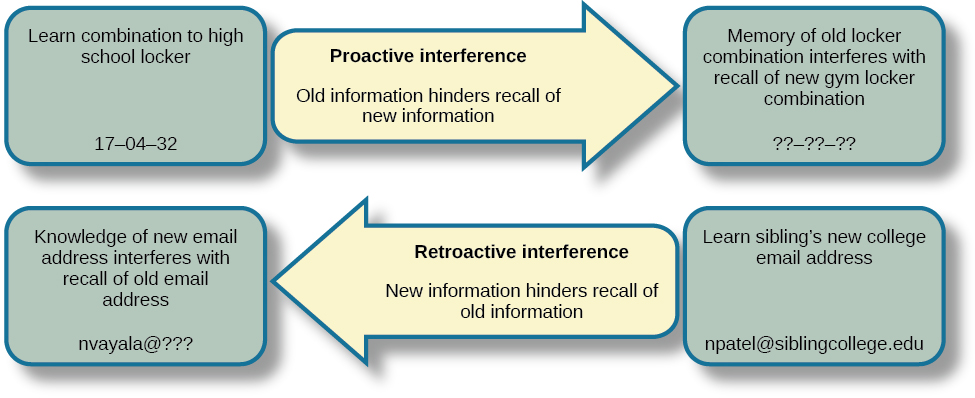Memory Errors
Psychologist Daniel Schacter (2001), a well-known memory researcher, offers seven ways our memories fail us. He calls them the seven sins of memory and categorizes them into three groups: forgetting, distortion, and intrusion (Table 1). We’ll look at them on this page and the next.
| Sin | Type | Description | Example |
|---|---|---|---|
| Transience | Forgetting | The accessibility of memory decreases over time | Forget events that occurred long ago |
| Absentmindedness | Forgetting | Forgetting caused by lapses in attention | You forget where your phone is |
| Blocking | Forgetting | Accessibility of information is temporarily blocked | Tip of the tongue |
| Misattribution | Distortion | Source of memory is confused | Recalling a dream memory as a waking memory |
| Suggestibility | Distortion | False memories | The result from leading questions |
| Bias | Distortion | Memories distorted by current belief system | Aligning memories to current beliefs |
| Persistence | Intrusion | Inability to forget undesirable memories | Traumatic events |
Errors of Forgetting
Transcience
transience
Transience refers to the tendency of memories to fade over time, or the process by which memories become less accessible or less easily retrieved. For example, maybe a friend mentions a book you read several years ago. You recall that you enjoyed reading the book but can’t actually remember the storyline when they ask you about it.
What is going on here is storage decay: unused information tends to fade with the passage of time.
The Forgetting Curve
In 1885, German psychologist Hermann Ebbinghaus analyzed the process of memorization. First, he memorized lists of nonsense syllables. Then he measured how much he learned (retained) when he attempted to relearn each list. He tested himself over different periods of time from 20 minutes later to 30 days later. The result is his famous forgetting curve (Figure 1).
the forgetting curve
Due to storage decay, an average person will lose 50% of the memorized information after 20 minutes and 70% of the information after 24 hours (Ebbinghaus, 1885/1964). Your memory for new information decays quickly and then eventually levels out.

Interference
Another reason for memory transience is memory interference, when other information conflicts with the remembered information. There are two types: proactive interference and retroactive interference.
proactive and retroactive interference
Proactive interference is when old information hinders the recall of newly learned information. Have you ever gotten a new phone number or moved to a new address, but right after you tell people the old (and wrong) phone number or address? When the new year starts, do you find you accidentally write the previous year? These are examples of proactive interference.
Retroactive interference happens when information learned more recently hinders the recall of older information. For example, this week you are studying about memory and learning about the Ebbinghaus forgetting curve. Next week you study lifespan development and learn about Erikson’s theory of psychosocial development, but thereafter have trouble remembering Ebbinghaus’s work because you can only remember Erickson’s theory.

Absentmindedness
Are you constantly losing your cell phone? Have you ever driven back home to make sure you turned off the stove? Have you ever walked into a room for something, but forgotten what it was? You probably answered yes to at least one, if not all, of these examples—but don’t worry, you are not alone.
We are all prone to committing the memory error known as absentmindedness. Absentmindedness happens when your attention is elsewhere during encoding. It’s not that the memory faded—you never fully stored it.
Blocking
Blocking occurs when a memory is in there, but temporarily inaccessible. It is also known as the tip-of-the-tongue (TOT) phenomenon. The memory is right there, but you can’t seem to recall it, just like not being able to remember the name of that very famous actor you saw in a movie, even though you can name the movie and describe what he looks like.